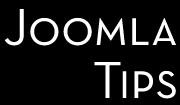Ajax is not a genuine Joomla technology, it is just one of programming techniques to made a web page more attractive.
The Joomla Language
Joomla's roots are going back more, than a decade (remember, Joomla is a fork of the Mambo CMS, and the development was started in 2000) , - lot of time in the Internet's dog-years, and it definitely has a language of its own. Seasoned veterans are fluent in Joomla 's own language, but for "newbies", this speak can be confusing at best, if not unintelligible or meaningless talk or writing; gibberish in nutshell. This fact can be a main obstacle for ones want to start using/mastering Joomla. This is a reason we began to compile a Joomla-to-English dictionary to help "translate" the usual Joomla-talk. The list of the most commonly used words and/or phrases in Joomla you'll find here is incomplete, and the given definitions are arbitrary. We just attempt to find some "translations" that actually meaning something to a non-veteran Joomla user too. The list is open, the content is not nailed down, any suggestion/addition/request is highly appreciated!
YOnce the basic setup is done, yo need to tweak your Joomla installation to behave as you need. you will need individual configuration settings for your website elements (components, plugins, modules, content pages, templates): in the Joomla lingo we call them options. These options are applied to the whole website, for users, categories, modules, components. Since Joomla 1.6 this has became standard: you will always find an icon named Options in the backend pages, which are providing you the interface to set your preferences for the given component.
For example in the Joomla 1.6+ in the template manager you have in the Options a way to switch on or off the support for the well known trick to append "?tp=1", which reveals you the available module positions for your templates.
Now you can block attempts to visualize by others these module positions by visiting the address:
http ://yourdomain.com/index.php?tp=1
BTW: The "tp" stands for template position and the trick is one of core Joomla tricks.
To find your way around the website, you will need navigation with corresponding links. In Joomla! we call this a menu. You may create as many menus as desired and nest them into as many different ways as you wish. Each menu is a module which can be positioned on a provided area in the template.
Important note: Joomla! is a genuinely menu driven system, the most important behaviors: as what module when to be shown, what template to be used on a certain page, etc all can be controlled using by associating behaviors to menu items. So, plan carefully your menu - it is the core of your site's end user experience!
One of frustrating questions for novice Joomlers is the question: What is the difference between a Joomla Component, a Module and a Plugin? This issue can seem rather confusing, but it is really worth understanding this, because this is a key issue in understanding, how Joomla works, and each of them have their specific role and way to set up and operate.
Sometimes, if more people work on the site, you can get locked out of a certain module or article because the site thinks someone else is still editing that item. When opened, each Joomla item is checked out, this way Joomla protects each editable item from being edited by two separate users at the same itme, and this way avoiding potential confusion and other obvious problems.
ACL stands for access control levels. It refers to who has permission to do what on the website, including read, create, edit, delete, or log in, among other permissions.
Many think of ACL as relating to the front end of a website only. For example, when I log into the website, what articles do I have available to me? And if someone else logs into the site, do they see the same articles, or do they see different ones?
